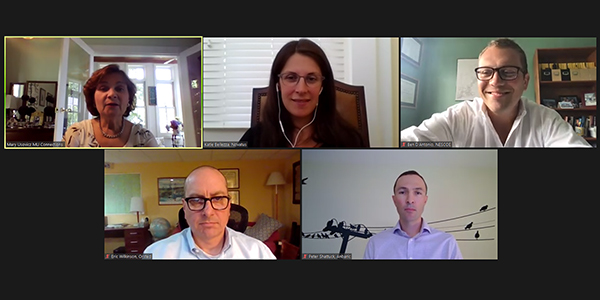New England needs to build much more onshore transmission to facilitate the incoming surge of offshore wind generation, panelists on a Northeast Energy and Commerce Association webinar said Wednesday.
NECA convened the webinar to discuss how much offshore wind New England can integrate, with representatives from the New England States Committee on Electricity (NESCOE), Anbaric Development Partners and RENEW Northeast summarizing the results of studies their organizations requested from ISO-NE Planning Advisory Committee Briefs: June 17, 2020.)
NESCOE counsel and analyst Ben D’Antonio provided an overview of ISO-NE’s findings under the organization’s requested assumptions. The RTO concluded that about 5.8 GW of offshore wind can be interconnected using AC transmission without significant upgrades to the onshore grid. That’s “if you do it in a strategic way,” at certain points of interconnection, D’Antonio said.
But “above that threshold … major reinforcements to the system were identified as being necessary.” The RTO identified at least four 345-kV onshore lines that would need to be built to facilitate additional offshore resources.
It also determined that it’s possible to interconnect up to an additional 2.2 GW — for a total of 8 GW — through long-distance HVDC lines without the need for new onshore transmission. But regardless of the solution, it found the costs to reaching the 8-GW mark were comparable: about $1 billion, D’Antonio said.
Perhaps more stark, however, is the huge amount of renewable energy that would be “spilled,” or curtailed, even with the additional transmission identified: more than 15 TWh/year. Most of that is attributable to oversupply during the fall and spring shoulder months, when load is low, and not to transmission congestion.
“This loss of clean generation can undermine state initiatives to reduce our carbon footprint,” said Katie Bellezza, senior vice president of commercial management and strategy for Novatus Energy, a RENEW member. RENEW’s study focused on Maine’s existing onshore wind, which already experiences significant curtailment.
“Land-based wind and new transmission is currently the least-cost renewable resource available in New England,” she said. “However, due to smaller procurements, it’s difficult to justify those transmission costs. With infrequent onshore renewable procurements of limited scale, we really need to look at other ways besides procurement to fund transmission.”
Anbaric requested that ISO-NE look at higher penetration levels than NESCOE, up to 12 GW. “When we put that request in just last year, it seemed potentially pretty ambitious, but it’s just been remarkable to see the [state OSW] goals increase,” said Peter Shattuck, Anbaric senior vice president for communications.
“When we look big-picture, what we need to avoid is the sort of situation we have now in Maine, where transmission was considered essentially an afterthought, and now there are a lot of bottled-up resources,” he said.
Shattuck also reviewed Anbaric’s proposed undersea transmission network and the Brattle Group’s analysis of it. (See Brattle Study Highlights Benefits of Offshore Grid.)
Moderator Mary Usovicz, principal of consulting firm MUConnections, brought up Eversource Energy and National Grid’s finalist bid in ISO-NE’s first competitive transmission solicitation under National Grid, Eversource Finalist for Boston Tx Plan.)
Usovicz asked the panelists whether they thought there was a better solution.
Shattuck, whose company submitted its own proposal, said, “It just seems like this decision was made on a very narrow, capital-cost basis, and that [basis] risks deferring the upgrades that are going to be needed [for OSW]. … It was essentially a missed opportunity to think bigger picture and really reflect the moment that we’re in right now in New England, where we need a grid that’s centered on renewables.”
“I’ll just kind of state the obvious and say that [decision] was done for reliability, and trying to right-size a solution for reliability is a little bit different than trying to right-size it for maybe a public policy-related issue,” D’Antonio said.






